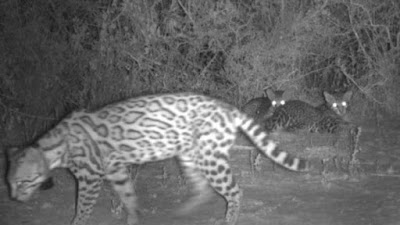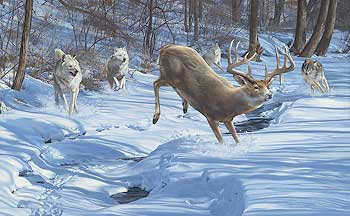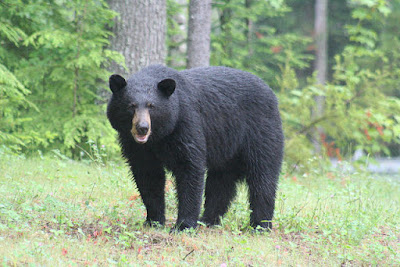You may wake up to the sound of coyotes howling in the weeks to come, because February is the peak of the coyote-mating season. Come April, 4 to 8 pups will be born in a den concealed in a brushy slope or under a log pile. The male coyote hunts for the female, bringing her food, which she regurgitates to feed her young. About 70 percent of the pups will die before their first birthday. The eastern coyote is a relative newcomer to New Hampshire.
The first coyote was seen in Holderness in 1944. During the 1970s and 80s, coyotes spread throughout the state. Today, they are entrenched statewide in every available habitat from rural to urban. Studies by Dr. Robert Wayne of the University of California on tissue samples of New England coyotes found a great deal of wolf blood related to the gray wolf of Quebec. This is why our coyotes, weighing 48-60 pounds, are nearly twice the size of the western species. Coyotes come in an array of colors, from creamy to rust-colored to tawny gray. Their erect, pointed ears and bushy, drooping tails distinguish them from dogs
. Coyotes are opportunists and eat all sorts of things, depending on the time of year. In the summer, they eat fruits and berries, insects and small mammals like rabbits, squirrels and mice. They'll also eat dead animals and prey on deer slowed by deep snow. New Hampshire trappers have harvested an average of 379 coyotes each year over the past decade. The coyote is the only furbearer species that has a year-round open season for hunting and trapping in the state, but this hasn't reduced New Hampshire's coyote population. No wonder this crafty canid is called "wily coyote!" --Eric Orff, Wildife Biologist; and Dr. Judy Silverberg, Wildlife Educatortent
---------------------------------------------------------------------------------------------------------------------------
Historic and Current Statewide Deer Population
The white-tailed deer population density in North America before European colonization was
approximately 10 per square mile (McCabe and McCabe 1984)
HISTORICAL INFORMATION
While population densities of white-tailed deer prior to European settlement are
uncertain, it is generally accepted that they were much lower than current populations.
Three distinct historical stages with regards to white-tailed deer populations can be
delineated. The first stage, pre-European settlement prior to 1700, can be characterized
by low deer densities.
Deer populations were regulated by cyclical harsh winters (every
10-20 years) which resulted in elevated mortality. Predators inhibited deer populations
from increasing significantly following severe winters. These predators included
carnivores like wolves and mountain lions and the several million indigenous people that
depended on deer for sustenance (Rooney 2001). These predators were only able to
regulate white-tailed deer numbers at the low densities that occurred during this era
(Eberhardt and Peterson, 1999).
Finally, population growth was hampered by the
depleted food resources made available by the composition and structure of the dense
mature forests (Leopold, 1943; McCaffery 1976).
---------------------------------------------------------------------------------------------------
https://www.google.com/url?sa=t&rct=j&q=&esrc=s&source=web&cd=4&cad=rja&uact=8&ved=0ahUKEwifkr6FxpjRAhVkxoMKHSdnCeUQFggsMAM&url=http%3A%2F%2Fnorthernwoodlands.org%2Farticles%2Farticle%2Ftoo-many-white-tails&usg=AFQjCNFyOxIHgsqObxpgmbyES4zq1XQI5A
Around northern New England and upstate New York, many landowners, foresters, and wildlife enthusiasts have similarly conflicting feelings about deer. The million-dollar question is: how many deer are too many? Is it when the population density reaches a certain number, like 16 or 20 deer per square mile? Is it when hunters complain that the deer are too skinny and that there are no trophy bucks? Is it when the deer population exceeds the habitat’s carrying capacity? Or when environmental impacts, like loss of wildflowers, become noticeable?
It’s none of these things, says Thomas Rawinski, a botanist with the U.S. Forest Service in Durham, New Hampshire, and an expert on deer overabundance. While all are factors, the criterion that tops all others is the cultural carrying capacity: the number of deer that people are happy having around.
“Every person has a different life experience with deer,” says Rawinski. “They may be orchardists or farmers, or they may have had a vehicle collision or Lyme disease.” All of these influences must be included in the process of deciding how many deer there should be. “Wildlife is owned by everybody, so everybody needs to make the decision.”
Still, a recent public comment period revealed that the region’s foresters would like to see the deer population reduced to a quarter of what it is today. At the same time, hunters in the area are complaining that deer numbers are down; they’re advocating for more deer
Foresters often have a front-row view of the damage “too many” deer can cause to the landscape. Wildflowers, such as trillium and showy lady’s slippers, can be especially hard hit. “Each adult white-tailed deer eats about 2,000 pounds a year,” says Charlie Fiscella, New York State chapter president of the Quality Deer Management Association “That’s one ton. Go out with clippers and see how long it takes you to clip one ton. It’s hard to do that, especially when the habitat is marginal.”
The Nature Conservancy is just finishing up a study finding that deer are one of the top threats to a healthy forest in New York State, and that oak and maple seedlings are a deer’s favored food source. Since woodlot owners and foresters are also fond of oaks and maples, the deer’s impact is deeply felt. As these commercially valuable hardwood species start disappearing, forest composition can be skewed to favor birch, beech, and hophornbeam.
When deer pressure is overwhelming, you get no seedling regeneration at all. This allows invasive species to fill the void and dominate the ecosystem. As the invasives grow, the deer continue to eat native plants and avoid the invasives, thus giving the invasives a perpetual advantage.
Biologists do caution, however, that deer sometimes get too much blame for bad forest regeneration. In a forest with even-aged trees and an overstory that lets in no light, it may be the tree canopy that’s suppressing the seedling growth. One study found only subtle differences in a deer-free, full-canopy forest plot.
Jeff Ward, chief scientist of the forestry and horticulture section of The Connecticut Agricultural Experiment Station, based in Windsor, Connecticut, has first-hand experience with deer-caused imbalances. “In one study area where there was a ‘high’ deer herd, there was a 100-acre patch that was almost pure Japanese barberry,” says Ward.
Cases when deer do eat invasive plants can be just as much a problem as when they don’t since eating seeds can help the invasives spread. “Several years ago, we gathered over 5,000 deer poops in a greenhouse to see what would grow from them,” said Scott Williams, a deer biologist at the Experiment Station. Thirty-two species of plant that germinated were not native to the state of Connecticut, including Carolina horsenettle, little hogweed, and lambsquarters. “Deer are able to transport hundreds of exotic plant seeds each day to new locations,” said Williams. “That’s one aspect of superabundant deer that people don’t consider.”
As forest composition changes, animals suffer, especially songbirds. The National Audubon Society reports that eastern wood pewees, indigo buntings, least flycatchers, yellow-billed cuckoos, and cerulean warblers are negatively affected when deer populations exceed 20 deer per square mile. At 40 deer per square mile, an area starts to lose eastern phoebes and robins. Ground nesters, including ovenbirds, grouse, woodcock, whippoorwills, and wild turkeys, are vastly reduced.
Clearly, deer influence the environment, but they can also negatively affect our own health and safety. Deer play a role in the spread of Lyme disease, as well as the emerging diseases babesiosis (which has malaria-like symptoms) and human granulocytic anaplasmosis (which has symptoms similar to the flu). They also cause more-direct harm in accidents with vehicles. According to the National Highway Traffic Safety Administration, about 150 people are killed in these accidents nationwide each year, while thousands more are injured. Property damage from such collisions totals $1 billion.
These experimental Pennsylvania patch cuts were done inside an enclosed area with a controlled deer population. Both cuts are 11 years old. Above, the controlled deer population was 10 deer per square mile. Below, 64 per square mile. Note poor regeneration.Photos by Susan Stout/USFS.
Many experts point to 15 to 20 deer per square mile as the level at which the negative environmental impacts of deer can be seen

























